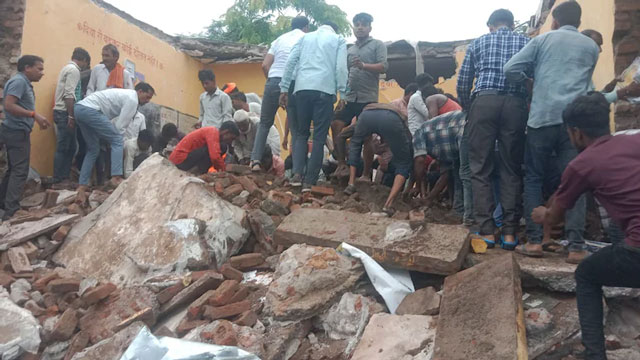Rajasthan School Building Collapse: 4 Children Dead in Piplodi, Negligence Blamed | Urgent Need for School Safety Reforms
By: Javid Amin | 25 July 2025
A Normal School Day Turns into a Nightmare
At around 9:00 AM on a seemingly regular morning, students of the Government Upper Primary School in Piplodi village, located in the Jhalawar district of Rajasthan, were attending their lessons, unaware that tragedy was seconds away.
The bell had rung. Children had just begun their classes. The atmosphere was filled with youthful chatter and the clatter of chalk on blackboards—until the roof above them gave way with a sudden, terrifying crash.
In a horrifying moment that will haunt the village for generations, the roof of one of the school’s classrooms collapsed, burying dozens of children under rubble and dust.
Four young lives were lost on the spot. Seventeen others were seriously injured, including three to four students who remain in critical condition.
This was not an earthquake. Not a storm. Not a natural disaster.
This was man-made. This was preventable.
And that is what makes this tragedy even more heartbreaking.
Where It Happened — Understanding Piplodi and Jhalawar
Piplodi is a remote village nestled in the Jhalawar district of southeastern Rajasthan. The area, known for its agrarian economy and modest living standards, depends heavily on government-run schools for children’s education.
Like many villages in Rajasthan, Piplodi’s government school was one of the few formal educational institutions accessible to the local children. Most families here are economically disadvantaged and rely on free public education.
The school building, reportedly constructed over 25 years ago, had become visibly worn down. Cracks were visible on the walls. Water seeped through ceilings during rains. The classrooms had not seen any renovation in years.
And yet, every day, dozens of children sat under that very roof.
The Collapse — What Exactly Happened?
According to eyewitnesses and local officials, the roof collapsed around 9:00 AM, just as morning classes had started. Around 60–70 children were inside the building.
Suddenly, with a loud crack and a plume of dust, the concrete roof of one of the classrooms caved in.
Desks shattered. Walls crumbled. Screams echoed.
Students were buried under debris—some instantly crushed, others pinned and injured.
Villagers rushed in. Teachers tried to pull students out. Chaos reigned.
Emergency services were informed immediately. Police, medical teams, and disaster response units arrived on the scene within the hour.
The rescue operation is ongoing, with district officials confirming four deaths so far. Seventeen children have been hospitalized at Manohar Thana Hospital. Three or four remain in critical condition, fighting for their lives.
Allegations of Negligence — Could This Have Been Prevented?
The school building collapse in Rajasthan has not just exposed weak infrastructure—it has exposed administrative failure and systemic negligence.
Ignored Warnings
Local villagers allege that complaints had been made repeatedly to the school authorities, the local education department, and even the district administration.
Parents had raised concerns about:
-
Cracks in classroom ceilings
-
Water leakage during rains
-
Visible rusting of the reinforcement bars
-
Fungal growth and weakened plaster
Yet no action was taken. Not even a temporary closure or relocation of classes.
Missing Safety Audits
As per government norms, school buildings—especially those more than 20 years old—must undergo regular structural safety audits. In this case, no such audit was done.
There were no red flags officially raised because no one bothered to check.
Voices from the Ground
“We knew this building was unsafe. We had told the teachers, the sarpanch, and even officials. Nobody listened.”
— Ramesh Verma, local parent
“This is not an accident. This is murder by negligence.”
— Sunita Meena, social activist from Jhalawar
The Emergency Response — Was It Fast Enough?
Within hours of the incident, local officials arrived at the site. District Collector Bharti Dixit and Rajasthan Education Minister Madan Dilawar reached Piplodi to supervise rescue operations and meet the injured students.
Medical Help
All injured students were taken to Manohar Thana Hospital, around 30 km from the site. The hospital has been overwhelmed but is providing round-the-clock care.
Those critically injured have been shifted to better-equipped facilities in Kota.
Rescue Teams in Action
Personnel from:
-
The State Disaster Response Force (SDRF)
-
Local police
-
Fire department
-
Community volunteers
…all worked together to remove debris using cutters, cranes, and even bare hands.
Some children were pulled out alive, albeit with severe injuries. Their survival is a testament to the swift local response, even if official systems failed them earlier.
Government Reaction — Promises and Politics
High-Level Inquiry Ordered
Rajasthan’s Education Minister, Madan Dilawar, has ordered a high-level probe into the incident. He visited the hospital and met with the families of the victims.
“We will not spare anyone found responsible. Those guilty of negligence will face strictest punishment.”
— Madan Dilawar, Rajasthan Education Minister
Compensation Promised
Chief Minister Bhajanlal Sharma announced:
-
₹5 lakh ex gratia for the families of the deceased
-
₹2 lakh for seriously injured students
-
Free medical treatment for all victims
But grieving parents say compensation means little when a life is lost.
Blame Game Begins
As expected, the tragedy has taken a political turn. Opposition parties, civil society, and media are questioning:
-
Why were safety norms ignored?
-
Why didn’t the education department act?
-
Why are thousands of such buildings still being used across India?
India’s Crumbling School Infrastructure — A National Problem
The school building collapse in Rajasthan is not an isolated case. Across India, lakhs of students study in schools that are:
-
Structurally unsound
-
Lacking basic amenities
-
Vulnerable to collapse during rain or earthquakes
Shocking Numbers
According to the Ministry of Education’s 2023 data:
-
Over 40,000 government school buildings in India are more than 30 years old
-
Around 20% lack proper structural safety certification
-
50% rural schools have never undergone safety audits
Who Is to Blame? Holding the Right People Accountable
Shared Responsibility
-
Education Department: Failed to audit or act on complaints
-
Local Administration: Ignored red flags and warnings
-
Political Leaders: Focused more on optics than systemic reform
-
Contractors & Engineers: Poor construction quality and no maintenance
-
Media & Public: Often ignore infrastructure until tragedy strikes
Demands from Civil Society
-
Arrest of negligent officials
-
Blacklisting of corrupt contractors
-
Criminal action for dereliction of duty
-
Time-bound judicial inquiry
-
Infrastructure audit of all government schools within 6 months
School Should Be a Safe Haven, Not a Death Trap
Parents send their children to school expecting them to be safe and protected.
But when classrooms turn into coffins, the very foundation of trust in public education crumbles.
This incident has not only shattered families but also sparked fear among millions of other parents.
Until our schools are safe, how can we claim to provide universal education?
What Needs to Be Done — The Road Ahead
Immediate Measures
-
Structural audit of all government schools in Rajasthan
-
Suspension of unsafe buildings
-
Relocation of students to safe campuses or temporary learning centers
Long-Term Policy Reforms
-
Central database for school infrastructure status
-
Mandatory structural audits every 5 years
-
Public display of building safety ratings
-
Increased budget allocation for school repairs and safety
-
Community monitoring via school management committees
Involving the People
Crowdsourced platforms for parents and students to report infrastructure issues anonymously can be a game-changer. Transparency tools can help bridge the trust gap.
The Voices That Matter — Stories of the Victims
Let’s not reduce this to numbers.
Each child had a name, a dream, and a family.
Aarti Sharma, 10
Wanted to become a teacher. Always came early to school and helped clean the classroom.
Wasim Ali, 12
Excelled in science. His father works as a daily wage laborer and hoped his son would break the poverty cycle.
These were not just “victims.” They were India’s future.
National Mourning, Collective Shame
The school building collapse in Rajasthan is not just a local tragedy—it’s a national shame.
This must not fade from headlines within a day.
It should remain etched in policy debates, parent-teacher meetings, and the conscience of every administrator.
Bottom-Line — Never Again
We have two choices now:
-
Treat this as another headline
-
Or ensure no other child dies in a government school due to a preventable building collapse
This is the wake-up call India cannot afford to hit snooze on.
Let this be the last tragedy of its kind.



